Welcome to Oristano, an area of stunning natural beauty and home to an abundance of birds. From the majestic eagles soaring above to the tiny wrens flitting from bush to bush, Oristano’s bird life is a joy to behold.
Whether you’re a passionate bird-watcher or just want to admire their beauty, Oristano is a great place to explore. With over 80 species of birds, including rare and endangered species, you’re sure to find something special.
So grab your binoculars and come explore the wonderful bird life of Oristano!
1. Sardinian Warbler
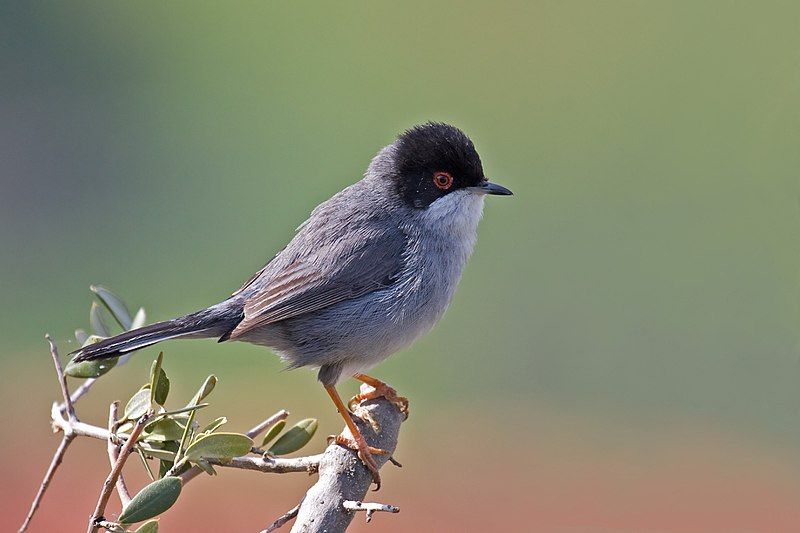
The Sardinian warbler is a species of warbler found in the Mediterranean region. It is classed as a typical warbler, and is quite widespread and common. This species has two distinct plumages, one for the male and one for the female.
The adult male has a grey back, white underparts, and a black head. It also has a white throat and red eyes which are helpful for identification. The female is generally paler in colour than the male, and may have some streaks on the back and face.
Both the male and female have a short bill and a short tail. They feed mainly on small insects, although sometimes they will eat berries. The Sardinian warbler is an important species in its native habitat, helping to keep insect populations in check.
| Kingdom | Animalia |
| Phylum | Chordata |
| Class | Aves |
| Order | Passeriformes |
| Family | Sylviidae |
| Genus | Curruca |
| Species | C. melanocephala |
2. Eurasian Collared Dove
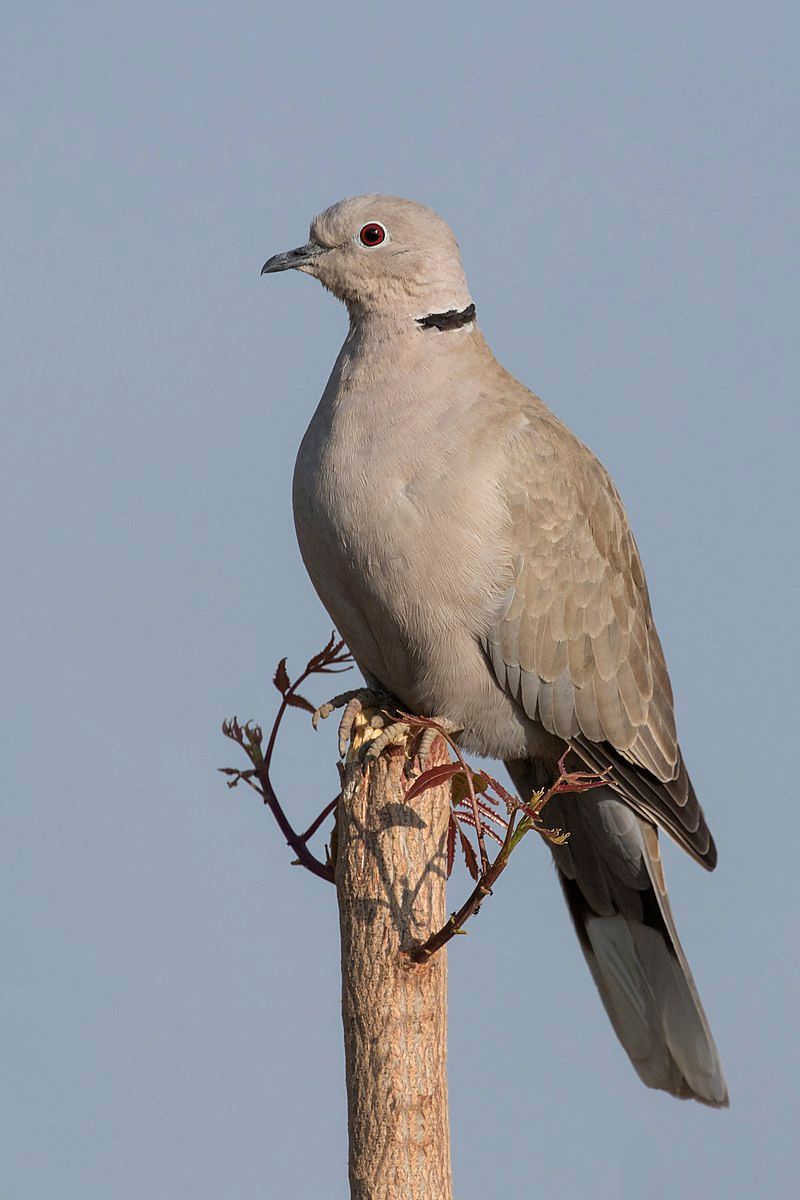
The Eurasian collared dove is a species of dove native to Europe and Asia. It is a species of medium-sized dove, characterized by a pale grey head and neck, a white collar around its neck, and a light brown body.
The Eurasian collared dove was introduced to Japan, North America, and several islands in the Caribbean. It is thought that the introduction of this species to these regions was done intentionally, as it became a popular pet bird.
In Japan, the Eurasian collared dove has become a common sight in urban areas, as it has adapted to the human-altered landscape.
In North America, the Eurasian collared dove has spread across the continent, with its range expanding from the east coast all the way to the west coast. It has also been observed on islands in the Caribbean, where its presence is likely due to intentional introductions.
The Eurasian collared dove is a species that is able to adapt to different environments, and its presence in these regions is an example of this ability.
| Kingdom | Animalia |
| Phylum | Chordata |
| Class | Aves |
| Order | Columbiformes |
| Family | Columbidae |
| Genus | Streptopelia |
| Species | S. decaocto |
3. Greater Flamingo
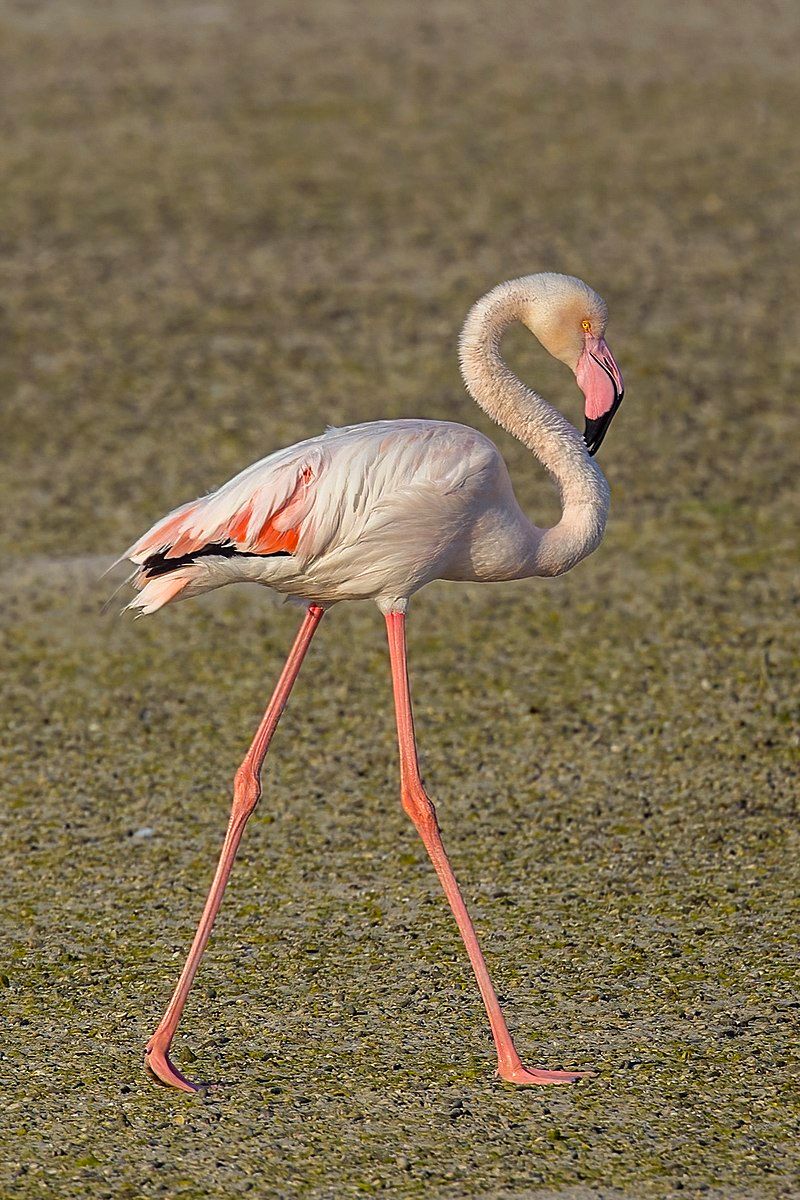
The greater flamingo is a species of the flamingo family that is found in many different parts of the world. It is the most widespread and largest species in its family, and is commonly found in the Old World.
This includes Northern and Sub-Saharan Africa, the Indian Subcontinent, the Middle East, the Levant, the Persian Gulf, the Gulf of Aden, the Red Sea, and the Mediterranean countries of Southern Europe.
This species of flamingos is known for its large size and the wide range of its distribution. The greater flamingo is an iconic species of bird. It has pink feathers and a long neck, and its long legs are usually white with pink accents.
It also has a distinctive curved bill, which is used to filter food out of the water. The flamingo usually feeds on shrimp, plankton, and other small aquatic organisms.
It has a unique way of feeding, known as sieving, wherein it filters water through its bill and catches prey that it can eat. The greater flamingo lives in shallow lagoons, lakes, and other water bodies with a large concentration of food sources.
It is also known to inhabit marshes, mudflats, and salt pans. In some areas, it is found in large flocks, while in other areas it can be found in smaller numbers. The greater flamingo is an important species for its ecosystem.
It helps to maintain the balance of the food web by consuming a variety of aquatic organisms, as well as providing an important food source for other species. It is also an important species for ecotourism, as it is a popular sighting for birdwatchers.
| Kingdom | Animalia |
| Phylum | Chordata |
| Class | Aves |
| Order | Phoenicopteriformes |
| Family | Phoenicopteridae |
| Genus | Phoenicopterus |
| Species | P. roseus |
4. Squacco Heron
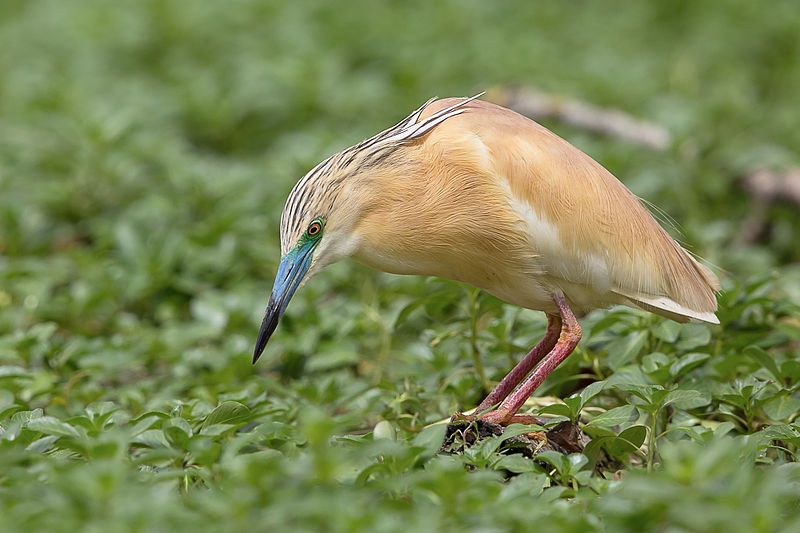
The Squacco Heron is a species of small heron found in the Old World. It is roughly 44-47 cm in length, with a body length of 20-23 cm and a wingspan of 80-92 cm.
This species breeds primarily in Southern Europe and the Greater Middle East, where it is a common sight in wetlands, marshes, and other wetland habitats. Its diet consists of a variety of small fish and aquatic insects, and it can be seen foraging for food in shallow waters.
The Squacco Heron is an elegant species, with its white plumage and long neck making it an impressive sight. It typically nests in trees near bodies of water, and its loud, low-pitched calls can be heard during the breeding season.
The Squacco Heron is a valuable member of many wetland habitats, and its presence is essential for maintaining the health of these ecosystems.
| Kingdom | Animalia |
| Phylum | Chordata |
| Class | Aves |
| Order | Pelecaniformes |
| Family | Ardeidae |
| Genus | Ardeola |
| Species | A. ralloides |
5. Great Cormorant
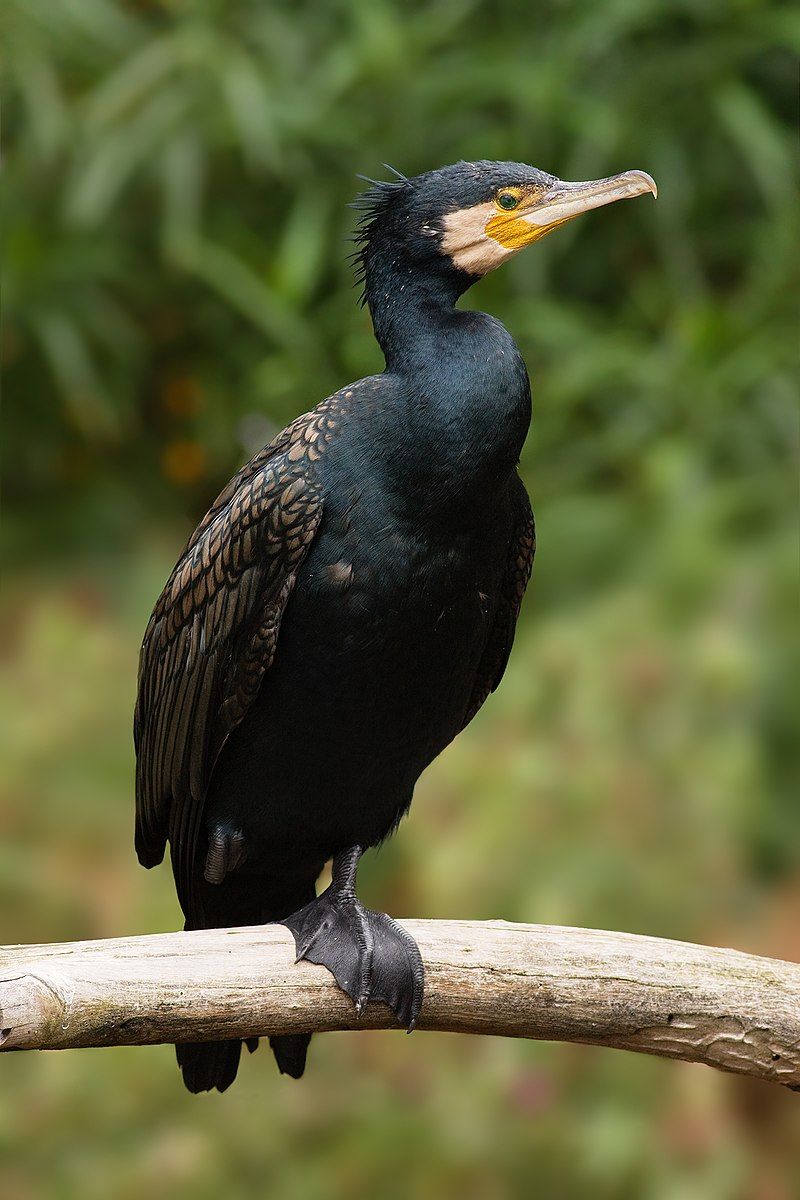
The great cormorant is a widespread seabird of the cormorant family. It is found around the world and has a variety of different names in different regions.
In New Zealand, it is called the black shag or kawau, while in the Northern Hemisphere, it is known as the great black cormorant. In Australia, it is known as the black cormorant, and in India, it is called the large cormorant.
The great cormorant is a large sea bird, typically black in color, with a long yellow bill and a humped back. It has long wings and webbed feet, making it well-adapted for swimming and diving.
The great cormorant is usually found near the shoreline, and it feeds mainly on small fish, crustaceans, and other aquatic creatures. It is a social bird and can often be seen in large groups, soaring over the water or perched on rocks near the shore.
| Kingdom | Animalia |
| Phylum | Chordata |
| Class | Aves |
| Order | Suliformes |
| Family | Phalacrocoracidae |
| Genus | Phalacrocorax |
| Species | P. carbo |
6. Common Moorhen
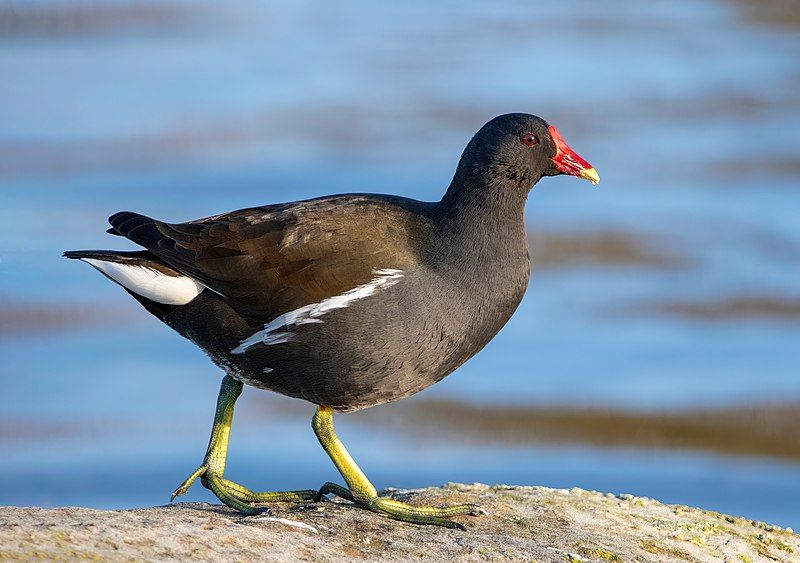
The common moorhen, also known as the waterhen or swamp chicken, is a bird species that belongs to the rail family. It is found in many parts of the world, with a particularly large population in the Old World.
This species of bird is well-adapted to a wide variety of habitats, and can often be found living in or around well-vegetated wetlands such as marshes, ponds, and canals.
Their preferred environment is one that is densely vegetated and offers plenty of food and cover from predators. Common moorhens are mainly ground-dwelling birds, but they are adept swimmers and can take flight when threatened.
They feed mainly on small aquatic invertebrates such as insects and crustaceans, but will also take small fish, amphibians, and other small animals. They are also known to be omnivorous, and will feed on plants, grains, and seeds.
Common moorhens can be identified by their dark grey-brown plumage, white underparts, and distinctive red bill and frontal shield. They are quite vocal, producing a variety of calls and other sounds to communicate with one another.
The common moorhen is a fairly common and widespread species and is an important part of many wetland ecosystems.
| Kingdom | Animalia |
| Phylum | Chordata |
| Class | Aves |
| Order | Gruiformes |
| Family | Rallidae |
| Genus | Gallinula |
| Species | G. chloropus |
7. Yellow-Legged Gull
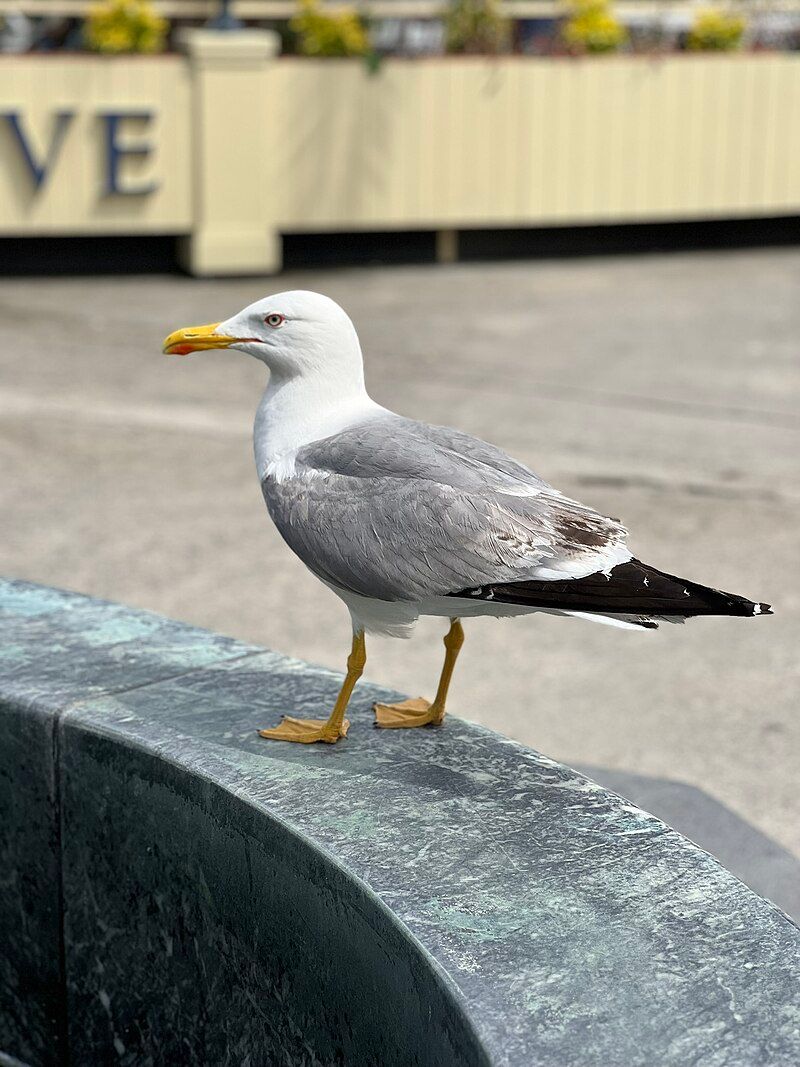
The yellow-legged gull is a large species of gull that is typically found in Europe, the Middle East, and North Africa.
It has only recently been recognized as a distinct species, which is notable given that it was formerly treated as a subspecies of the Caspian gull (Larus cachinnans) or even more broadly as a subspecies of the herring gull (Larus argentatus).
Although the yellow-legged gull is traditionally found in the regions mentioned above, there have been recent sightings in other places, including the United States. The yellow-legged gull is a large bird, with a wingspan that can reach up to 170 cm.
The adult bird has yellow legs, a yellow bill, and a grey back. The juvenile bird is similar in appearance but has a brown back. The yellow-legged gull is a social bird, often seen in large flocks, and is usually found near the coast or in wetlands.
It feeds on a variety of items, including fish, crustaceans, insects, and even carrion. Although the yellow-legged gull is a fairly common species, its population is decreasing due to habitat loss and disturbance.
It is currently listed as a species of least concern on the IUCN Red List, but further research is needed to ensure that the population remains stable.
| Kingdom | Animalia |
| Phylum | Chordata |
| Class | Aves |
| Order | Charadriiformes |
| Family | Laridae |
| Genus | Larus |
| Species | L. michahellis |
8. Black-Winged Stilt
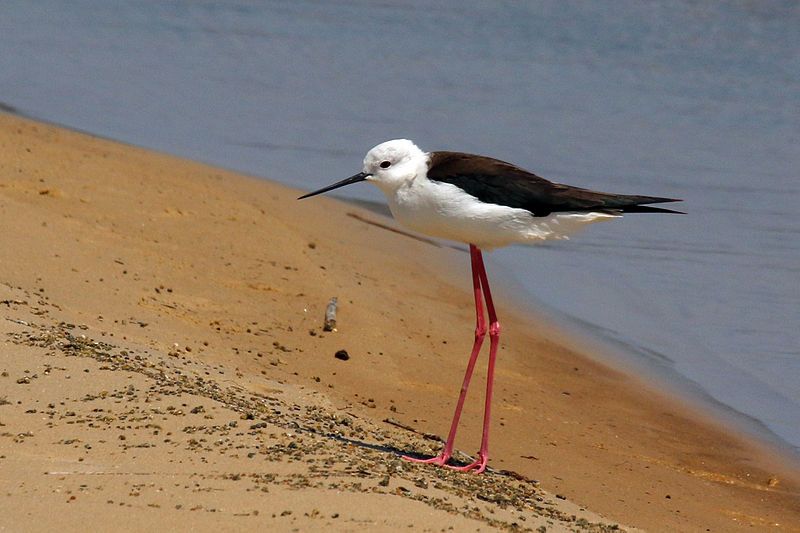
The black-winged stilt is a member of the avocet and stilt family of wading birds, which is characterized by its long legs. The scientific name of the species is H. himantopus and it is found in many parts of the world, making it almost cosmopolitan.
The black-winged stilt is a medium-sized wader that typically has a white body and black wings and legs. Its long legs allow it to wade in both shallow and deeper water. It feeds on a variety of small aquatic animals, such as insects, worms, shrimp, and small fish.
The black-winged stilt is a gregarious bird and is often seen in large flocks, sometimes with other wading birds. It is a graceful and agile flyer, and it can migrate long distances in search of food.
Despite its wide distribution, the black-winged stilt is vulnerable to habitat destruction and other disturbances, which has led to its conservation status being listed as “near threatened.”
| Kingdom | Animalia |
| Phylum | Chordata |
| Class | Aves |
| Order | Charadriiformes |
| Family | Recurvirostridae |
| Genus | Himantopus |
| Species | H. himantopus |
9. Eurasian Wigeon
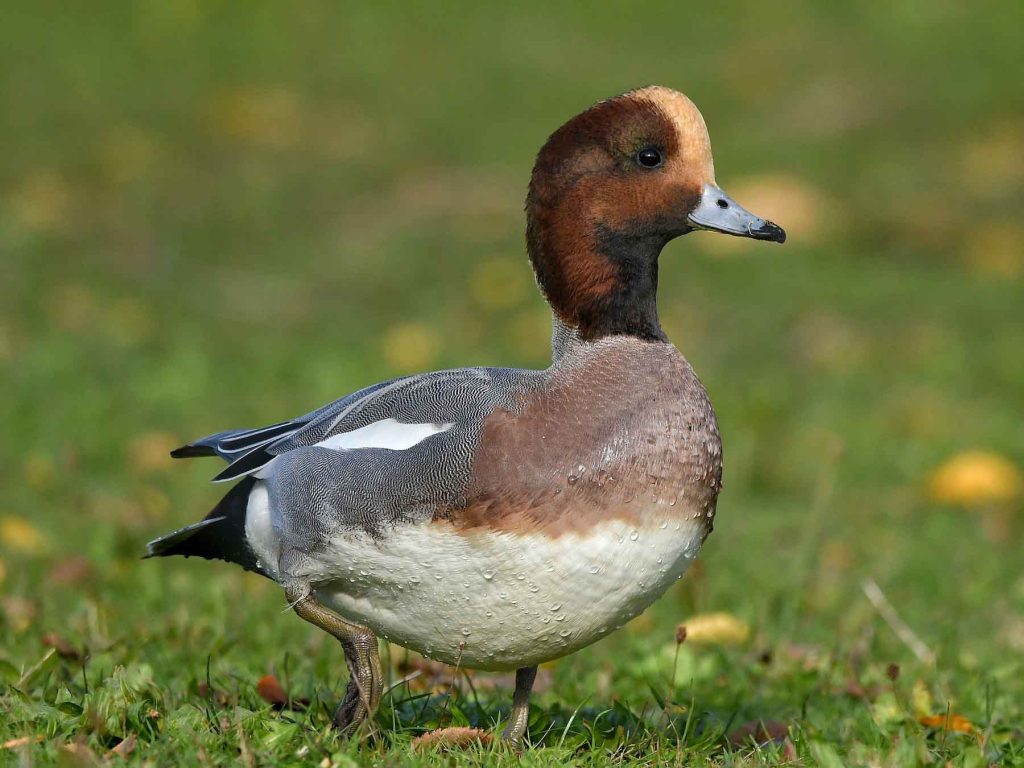
Source: ebird.org
The Eurasian wigeon, also known as the European wigeon, is a species of dabbling duck belonging to the genus Mareca. It is commonly found throughout its native Palearctic range, which spans from Europe and Asia to North Africa.
The Eurasian wigeon is a medium-sized duck and is easily recognizable due to its unique plumage. Its head, neck, and chest are white, while its back and wings are a mottled gray-brown color. It has a distinctive white patch on its wings, which is bordered by a black stripe.
This species is considered to be an important wintering bird in Europe, with large numbers of individuals wintering in the British Isles. It feeds mainly on aquatic plants and small invertebrates, which it obtains by upending in shallow waters.
This species also forms large flocks when not breeding and is highly gregarious. The Eurasian wigeon is an important species for hunters due to its large numbers and its attractive plumage.
| Kingdom | Animalia |
| Phylum | Chordata |
| Class | Aves |
| Order | Anseriformes |
| Family | Anatidae |
| Genus | Mareca |
| Species | M. penelope |
10. Pied Avocet
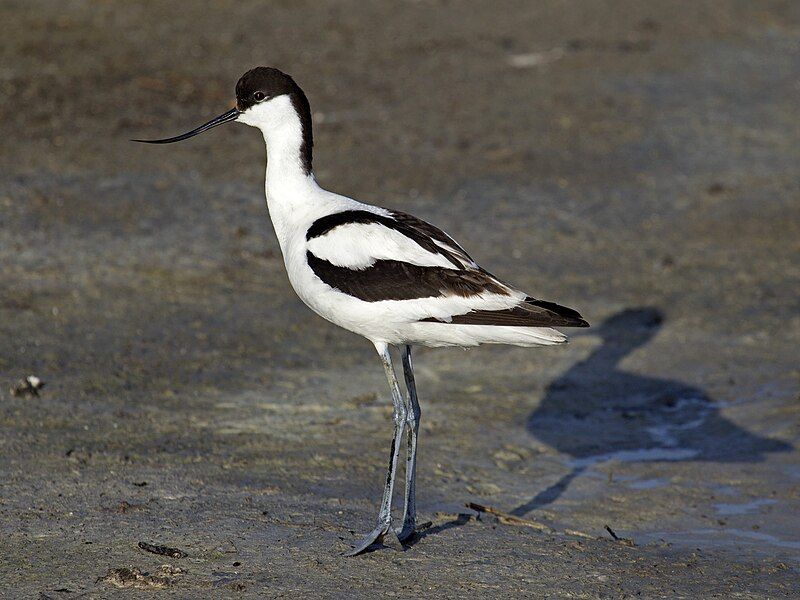
The pied avocet is a unique species of bird in the avocet and stilt family, Recurvirostridae. It is a large wader, with a black and white plumage. It is found across Europe during the temperate season and migrates to Central Asia during the winter.
It then continues to the Russian Far East before heading south for the winter, typically to Africa or southern Asia. As a migratory species, the pied avocet is a familiar sight on the move throughout much of Eurasia.
Its long-distance travel is an impressive feat and one that the bird undertakes several times a year. It is an adaptable species, able to survive and thrive in a variety of habitats from the coasts to inland wetlands.
The pied avocet is a symbol of resilience and determination, and it is an important part of the wildlife of Europe and beyond.
| Kingdom | Animalia |
| Phylum | Chordata |
| Class | Aves |
| Order | Charadriiformes |
| Family | Recurvirostridae |
| Genus | Recurvirostra |
| Species | R. avosetta |
11. Common Cuckoo
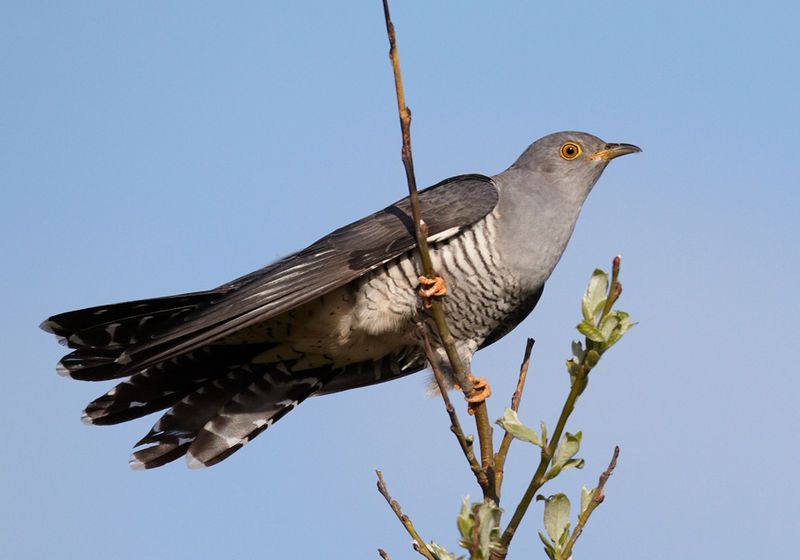
The Common Cuckoo is a species of bird belonging to the Cuculiformes order, which is a group of avian species that includes the Roadrunners, Anis, and Coucals. This species is found in many parts of Europe and Asia during the summer months when it migrates to these areas.
During the winter months, it migrates to Africa, where it remains until the summer season returns. The Common Cuckoo is a very distinctive species, with its long tail, gray or brown color, and its loud and recognizable call which it makes at dawn and dusk.
Its diet consists of insects, worms, and other invertebrates, which it catches on the ground or in mid-air.
It builds its nest in the hollow of a tree or bush, and lays its eggs in the nest of other birds, leaving them to be cared for by the unsuspecting host. The Common Cuckoo has a unique role in its environment, as it helps to control the population of some insect species by preying on them.
It is also a useful indicator species, as its presence and absence can be used to tell if the environment is healthy or not. The Common Cuckoo is an important species that plays an important role in its environment and is a species valued by birdwatchers, scientists, and nature lovers alike.
It is a reminder of the beauty and importance of nature, and its presence is something to be cherished and appreciated.
| Kingdom | Animalia |
| Phylum | Chordata |
| Class | Aves |
| Order | Cuculiformes |
| Family | Cuculidae |
| Genus | Cuculus |
| Species | C. canorus |
12. Red-Crested Pochard
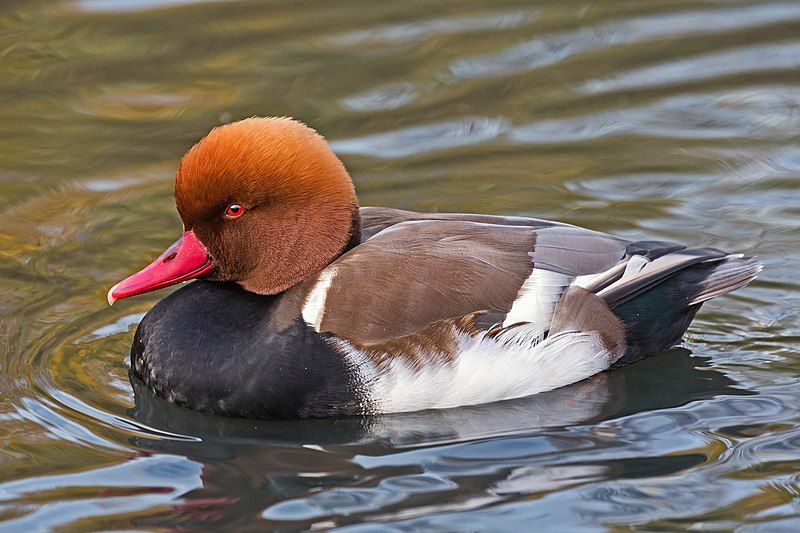
The red-crested pochard is a large, distinctive diving duck. Its scientific name, Netta rufina, reflects the bird’s physical characteristics. The genus Netta is derived from the Greek word for “duck”, while the species name rufina is Latin for “golden-red”.
This accurately describes the bird’s plumage: its head is a vibrant red, with a white patch on the chin, while its body is a golden-brown color. The red crest on the bird’s head is what gives the bird its name.
This eye-catching feature is usually only visible when the bird is in breeding season. The red-crested pochard is a strong swimmer and can dive deep beneath the surface of the water to search for food.
It prefers to feed on aquatic vegetation and animal matter, which can include mollusks, fish, and crustaceans.
| Kingdom | Animalia |
| Phylum | Chordata |
| Class | Aves |
| Order | Anseriformes |
| Family | Anatidae |
| Genus | Netta |
| Species | N. rufina |
13. Ferruginous Duck
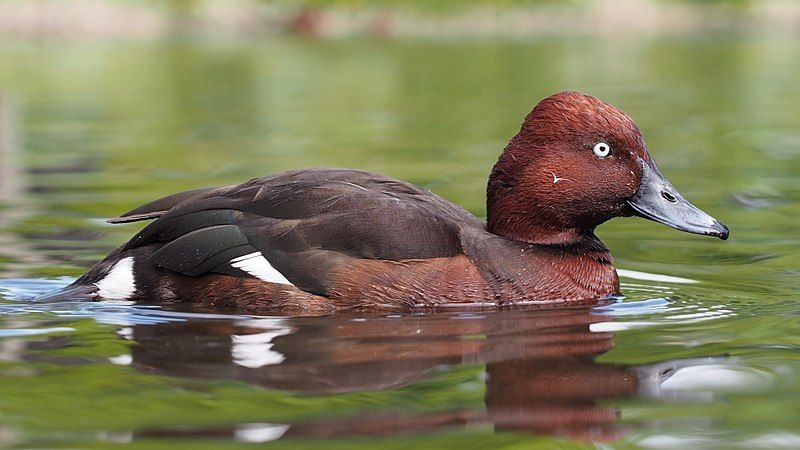
The ferruginous duck is a medium-sized diving duck native to Eurosiberia. It is also known as the ferruginous pochard, common white-eye or white-eyed pochard. The scientific name of the ferruginous duck is derived from the Greek words aithuia and nyrok.
Aithuia was an unidentified seabird mentioned by authors such as Hesychius and Aristotle. Nyrok, on the other hand, is the Russian name for a duck. This species of duck is characterized by its rusty-brown plumage, and long, pointed wings.
It can typically be found near lakes, large ponds, and rivers, where it feeds on aquatic plants and insects. The ferruginous duck is an important species in its native range, as it is a valuable game bird for hunters and a keystone species in many wetland ecosystems.
| Kingdom | Animalia |
| Phylum | Chordata |
| Class | Aves |
| Order | Anseriformes |
| Family | Anatidae |
| Genus | Aythya |
| Species | A. nyroca |
14. Pallid Swift
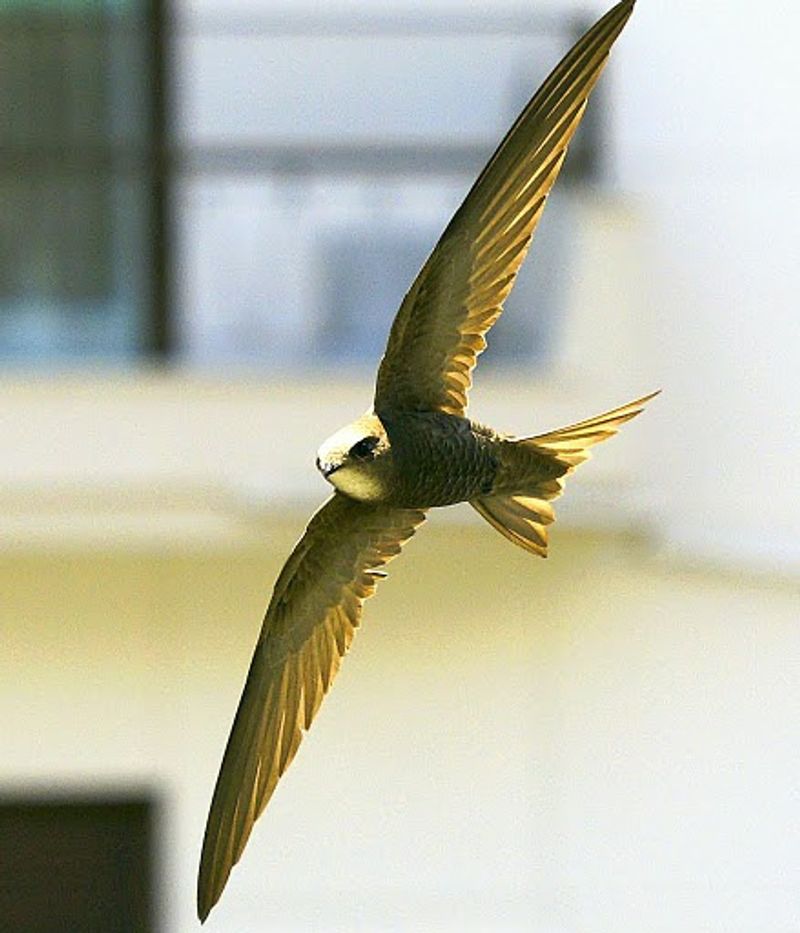
The pallid swift is a species of swift, a type of bird known for its ability to fly in quick, powerful bursts. They are so named due to their pale coloring, with the genus name Apus meaning “swift” in Latin and pallidus meaning “pale”.
Swifts have very short legs which they use only for clinging to vertical surfaces, such as the sides of buildings and cliffs, and are never seen voluntarily settling on the ground.
This is because their wings are adapted to allow them to stay aloft for extended periods, meaning that they can fly long distances without having to land. Due to their small size and fast-flying nature, pallid swifts are difficult to spot in the wild, making them a rare sight.
| Kingdom | Animalia |
| Phylum | Chordata |
| Class | Aves |
| Clade | Strisores |
| Order | Apodiformes |
| Family | Apodidae |
| Genus | Apus |
| Species | A. pallidus |
15. Great Egret
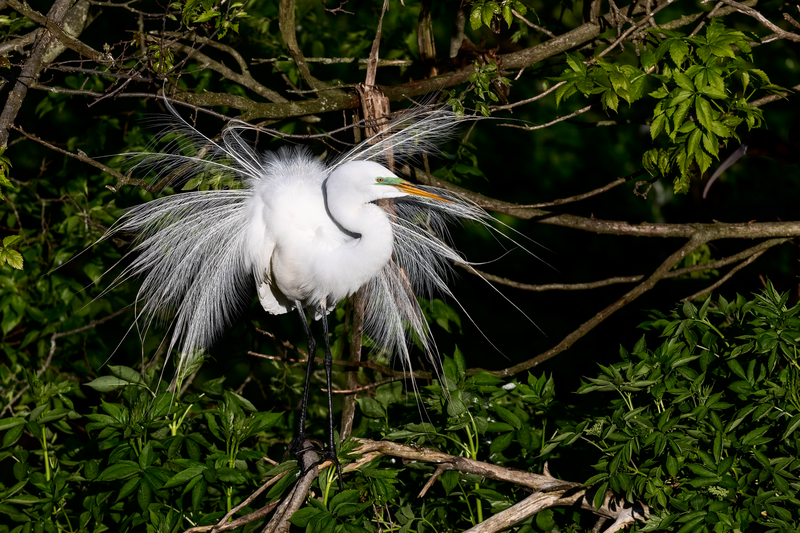
The great egret is a large, widely distributed bird species which is found in various parts of the world. It is also known as the common egret, large egret, great white egret, or great white heron.
It has four subspecies, which are found in Asia, Africa, the Americas, and southern Europe. In recent years, its range has been expanding and it is now being seen in more northern areas of Europe.
The great egret is a majestic bird which is easily recognizable by its long neck, broad wings, and long, white feathers. It typically stands up to three feet tall and has a wingspan of up to five feet.
Its diet consists of small fish, frogs, insects, and small reptiles, which it catches with its long beak. It has a preference for shallow wetlands and can often be seen wading in shallow waters in search of food.
The great egret is an important part of many ecosystems and is considered an important indicator species. It is a popular subject for wildlife photographers due to its striking white plumage and graceful movements.
Unfortunately, it is also threatened by habitat loss and pollution, which have caused a decline in its population. Conservation efforts are being made to protect this species and ensure its survival.
| Kingdom | Animalia |
| Phylum | Chordata |
| Class | Aves |
| Order | Pelecaniformes |
| Family | Ardeidae |
| Genus | Ardea |
| Species | A. alba |
16. Barbary Partridge
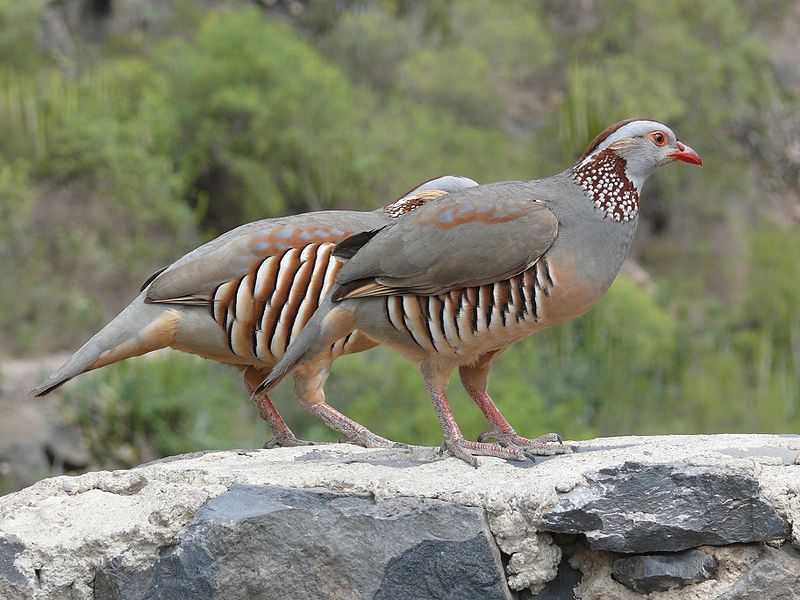
The Barbary partridge is a species of gamebird from the pheasant family (Phasianidae) of the order Galliformes. It is native to North Africa, and inhabits a range of habitats from semi-desert and steppes to mountain areas.
It is a small bird, measuring between 33 and 36 cm in length, with a mottled brown plumage and white barring on the wings.
The males have chestnut-brown heads, while the females have greyish-brown heads. The Barbary partridge feeds on a variety of foods, such as insects, seeds, and leaves, and is found in pairs or small groups.
It is commonly hunted for sport, and is also kept in captivity as a pet or for breeding.
It is an important game bird species, providing an important source of income for rural communities in its native range. The Barbary partridge is listed as a species of least concern by the International Union for Conservation of Nature (IUCN), although it has suffered some population declines due to habitat loss and hunting pressure.
It is protected in some areas, such as national parks and reserves, and hunting is regulated in others.
| Kingdom | Animalia |
| Phylum | Chordata |
| Class | Aves |
| Order | Galliformes |
| Family | Phasianidae |
| Genus | Alectoris |
| Species | A. barbara |
17. Bonelli’s Eagle
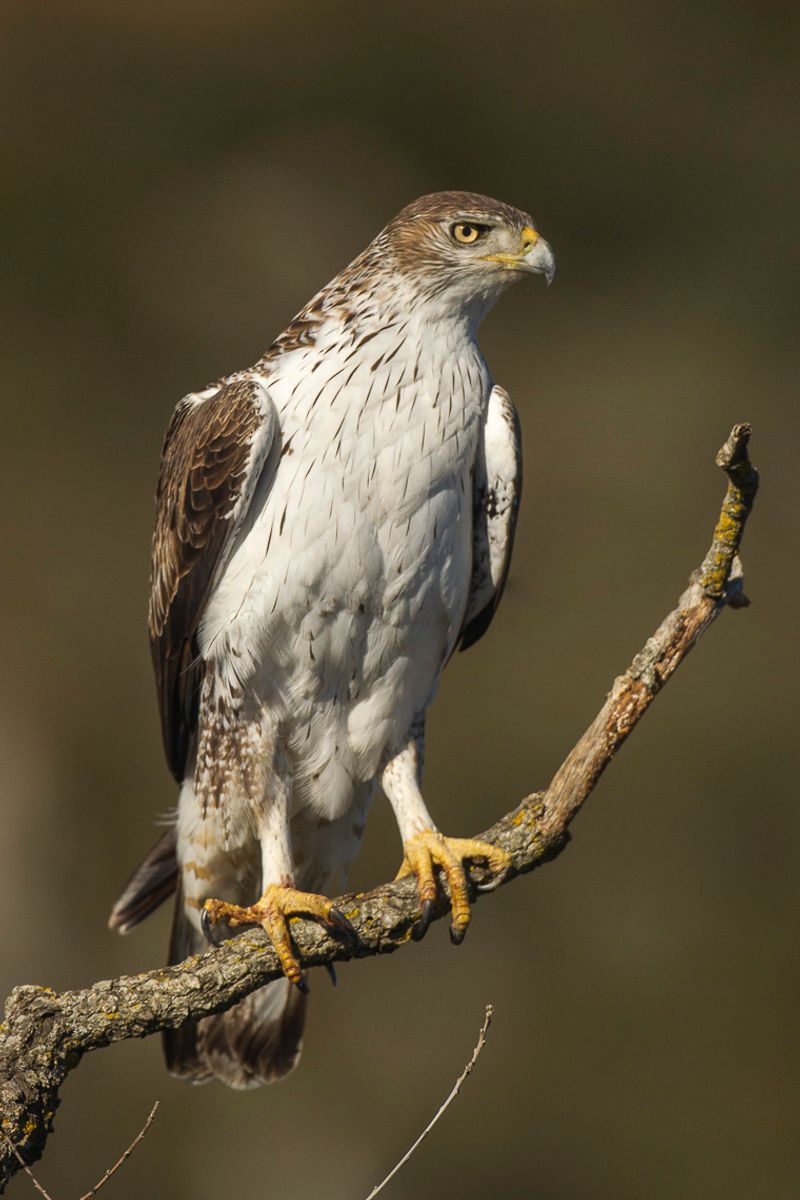
The Bonelli’s eagle is a species of bird of prey that inhabits a large range of the Mediterranean, from Spain to India. It is a medium-sized eagle, with a wingspan of up to 1.5m. Its scientific name, Aquila fasciata, means ‘feathered eagle’.
The common name of the bird commemorates the Italian ornithologist and collector Franco Andrea Bonelli, who is credited with discovering the species. Bonelli was likely on an exploration of Sardinia when he found the type specimen, and the species was named in his honour.
The Bonelli’s eagle is considered to be an endangered species, due to habitat loss caused by human activities such as logging and farming. Conservation efforts are ongoing to protect this raptor and its habitat.
| Kingdom | Animalia |
| Phylum | Chordata |
| Class | Aves |
| Order | Accipitriformes |
| Family | Accipitridae |
| Genus | Aquila |
| Species | A. fasciata |
18. Night Heron
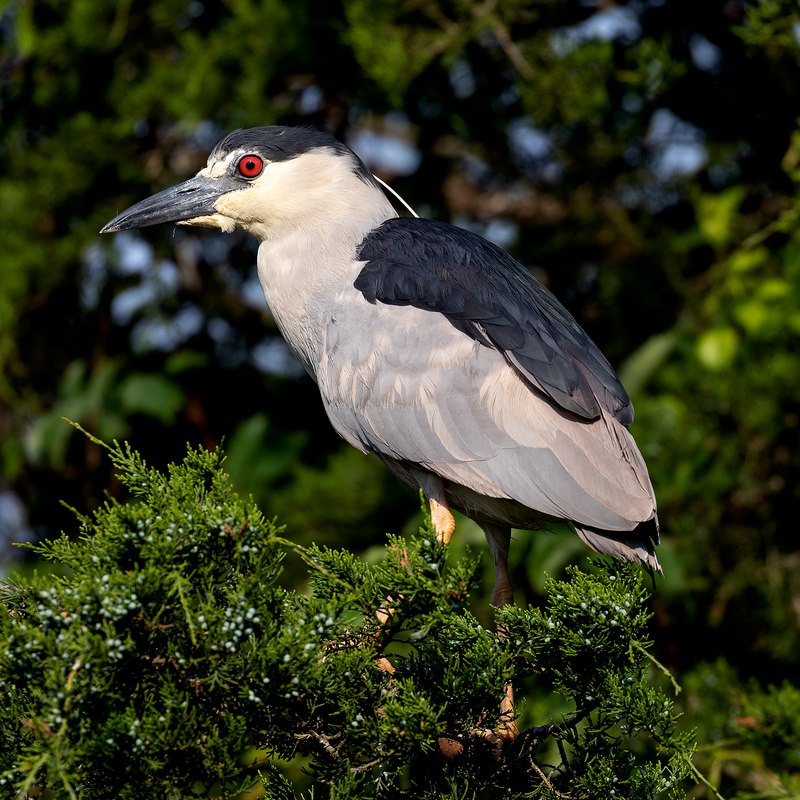
The black-crowned night heron, or black-capped night heron, is a species of heron that is found throughout many parts of the world. It is a medium-sized heron that goes by many names, most commonly being referred to simply as the night heron in Eurasia.
This bird is mainly found in parts of Europe, Asia, and North and South America.
It is a distinctive species due to its black crown and white head, as well as its long, pointed yellow bill and white throat. The black-crowned night heron is a solitary bird that prefers to dwell in wetland habitats such as marshes, lakes, and rivers.
It forages mainly at night, using its long bill to spear its prey, which includes fish, frogs, insects, and small reptiles. The species builds large nests in trees or reed beds near water, where they lay up to five eggs and incubate them for about three weeks.
The black-crowned night heron is listed as a species of least concern by the International Union for Conservation of Nature, due to its wide range and large global population. Its populations have, however, been decreasing due to habitat loss and degradation.
Conservation efforts are being made to help protect this species and its habitats, with the hope that future generations will be able to enjoy the beauty of this unique bird.
| Kingdom | Animalia |
| Phylum | Chordata |
| Class | Aves |
| Order | Pelecaniformes |
| Family | Ardeidae |
| Genus | Nycticorax |
| Species | N. nycticorax |
19. Common Pochard
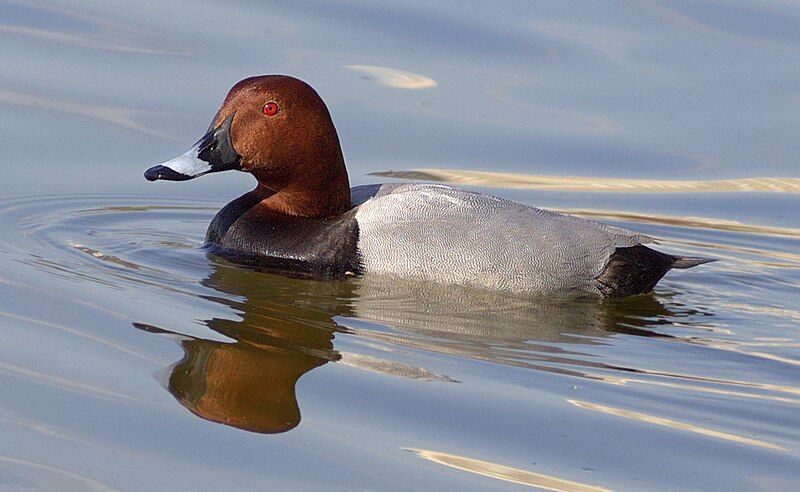
The common pochard is a medium-sized diving duck found in many parts of the world. Its scientific name is derived from two sources: the Greek aithuia and the Latin ferina. Aithuia was an unidentified seabird mentioned by ancient authors such as Hesychius and Aristotle.
Meanwhile, the Latin ferina is derived from the word ferus, which literally translates to “wild”. This is fitting, as the common pochard is a wild duck that is often hunted for its meat.
The combination of these two names – aithuia and ferina – is meant to signify that the common pochard is a wild, unidentified seabird.
| Kingdom | Animalia |
| Phylum | Chordata |
| Class | Aves |
| Order | Anseriformes |
| Family | Anatidae |
| Genus | Aythya |
| Species | A. ferina |
20. Common Shelduck
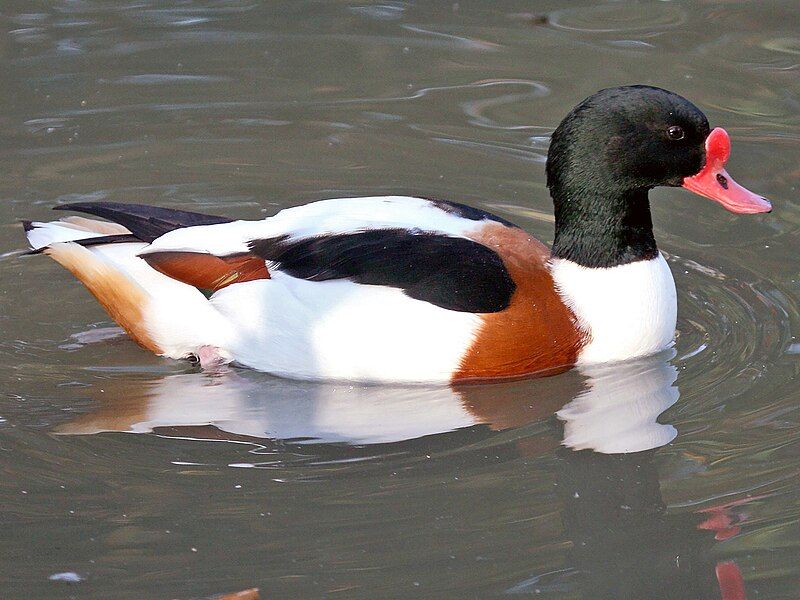
The common shelduck is a species of duck belonging to the genus Tadorna. It is found throughout the Euro-Siberian region of the Palearctic, a geographical area spanning parts of Europe and Asia.
In this region, the common shelduck typically breeds in temperate climates during the summer months, and then migrates to subtropical climates in the winter. These areas of subtropical climates are generally located in the Maghreb region, which encompasses parts of North Africa.
The common shelduck is a widespread and common species, and it is often seen in wetland habitats such as marshes, rivers, lakes, and estuaries. It is a large duck with a long bill, and its plumage is usually gray, white, and black.
The common shelduck is an omnivorous species, feeding on a range of plant matter, mollusks, crustaceans, and other small animals. During the breeding season, the common shelduck prefers to nest in cavities, such as holes in trees or cliffs.
The female typically lays around nine eggs in a clutch, and both parents take turns incubating and caring for the young. The common shelduck is an important species in the Palearctic region, and it plays an important role in local ecosystems.
| Kingdom | Animalia |
| Phylum | Chordata |
| Class | Aves |
| Order | Anseriformes |
| Family | Anatidae |
| Genus | Tadorna |
| Species | T. tadorna |
21. Tufted Duck
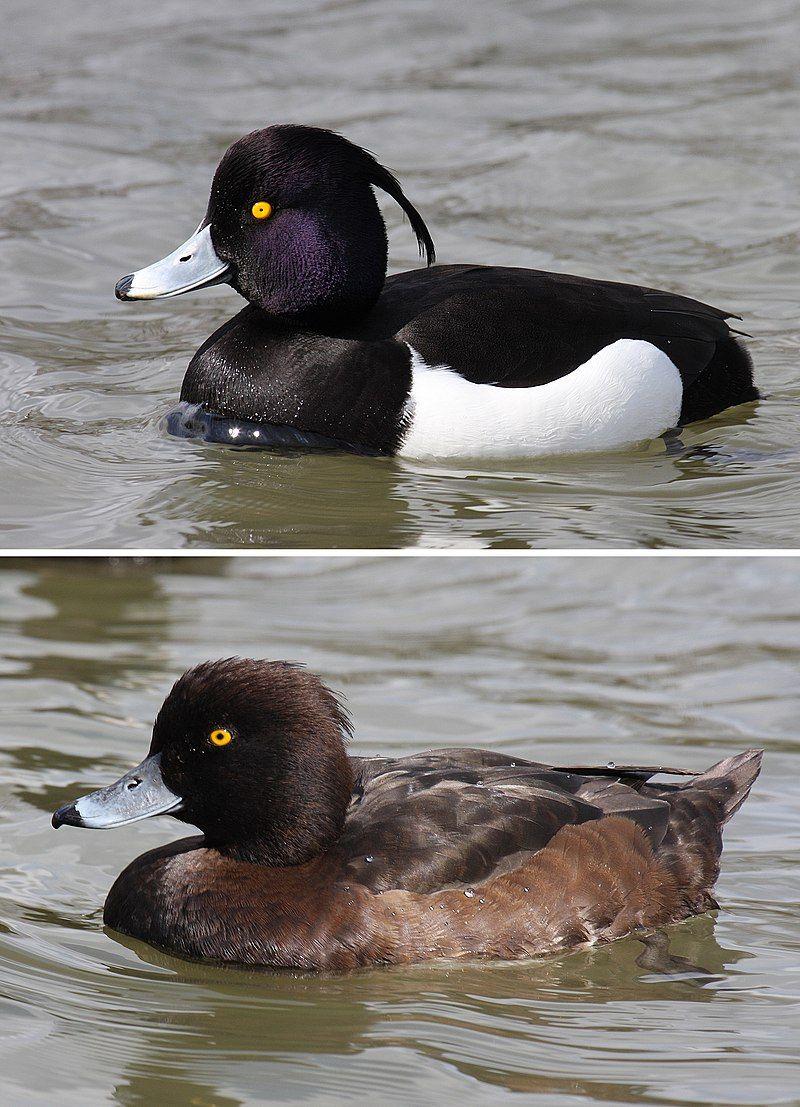
The tufted duck, also known as the tufted pochard, is an aquatic bird that is found in northern Eurasia. It is a small diving duck with a population of nearly one million birds.
The scientific name for the tufted duck is derived from the Ancient Greek word aithuia, which was a seabird mentioned by various authors such as Hesychius and Aristotle.
Additionally, the Latin words fuligo and gula, meaning “soot” and “throat” respectively, are also incorporated into the scientific name. The tufted duck has several features that help it to survive in its natural environment.
Its brown feathers are tipped with white, giving it a distinctive look. Additionally, its feet are webbed, which helps it to swim more easily and quickly when it is searching for food in the water.
It also has a long bill that is specially adapted for diving underwater to search for its prey. The tufted duck is an important species in its native environment. Its population numbers are closely monitored to ensure their survival and conservation.
Its presence helps to provide balance to its natural habitat and helps to keep the ecosystems in balance. Additionally, it is an important food source for other animals such as birds of prey, as well as providing food for humans.
| Kingdom | Animalia |
| Phylum | Chordata |
| Class | Aves |
| Order | Anseriformes |
| Family | Anatidae |
| Genus | Aythya |
| Species | A. fuligula |
22. Eurasian Scops Owl
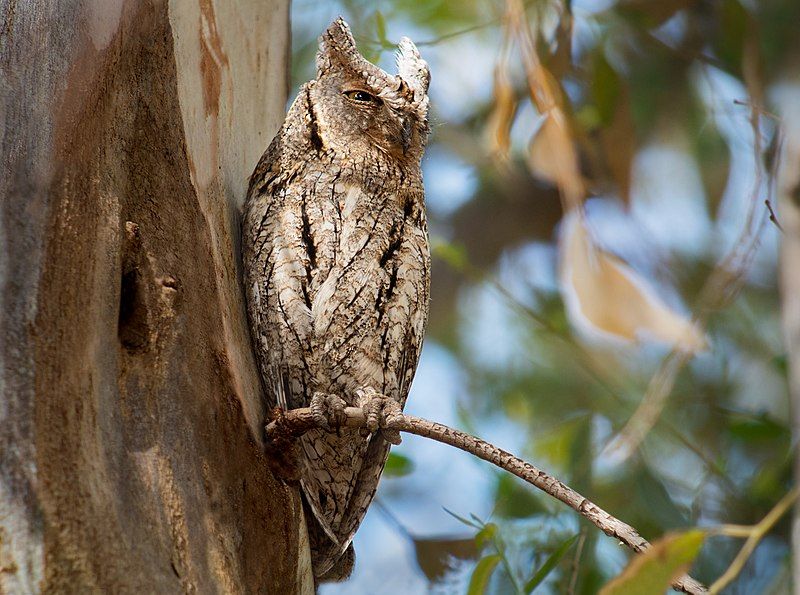
The Eurasian scops owl is a small owl found in the Strigidae family. It is widespread, with its breeding range stretching from southern Europe to southern Siberia and the western Himalayas.
This species is also migratory, meaning it spends the winter months in Africa south of the Sahara.
This species is also known as the European scops owl or simply the scops owl. This species is found in a diverse range of habitats, including open woodlands, grasslands, and coastal areas.
The Eurasian scops owl is typically nocturnal, and they feed mainly on insects, such as moths, beetles, and grasshoppers. They are relatively small owls, reaching a maximum length of 17 to 19 cm.
They are mostly grayish-brown in color, with dark streaks on the underparts. The Eurasian scops owl is considered to be of least concern in terms of conservation status.
However, their populations are believed to be in decline due to habitat destruction and other human activities. As such, conservation efforts are being taken to help protect this species and its habitat.
| Kingdom | Animalia |
| Phylum | Chordata |
| Class | Aves |
| Order | Strigiformes |
| Family | Strigidae |
| Genus | Otus |
| Species | O. scops |
23. Rock Dove
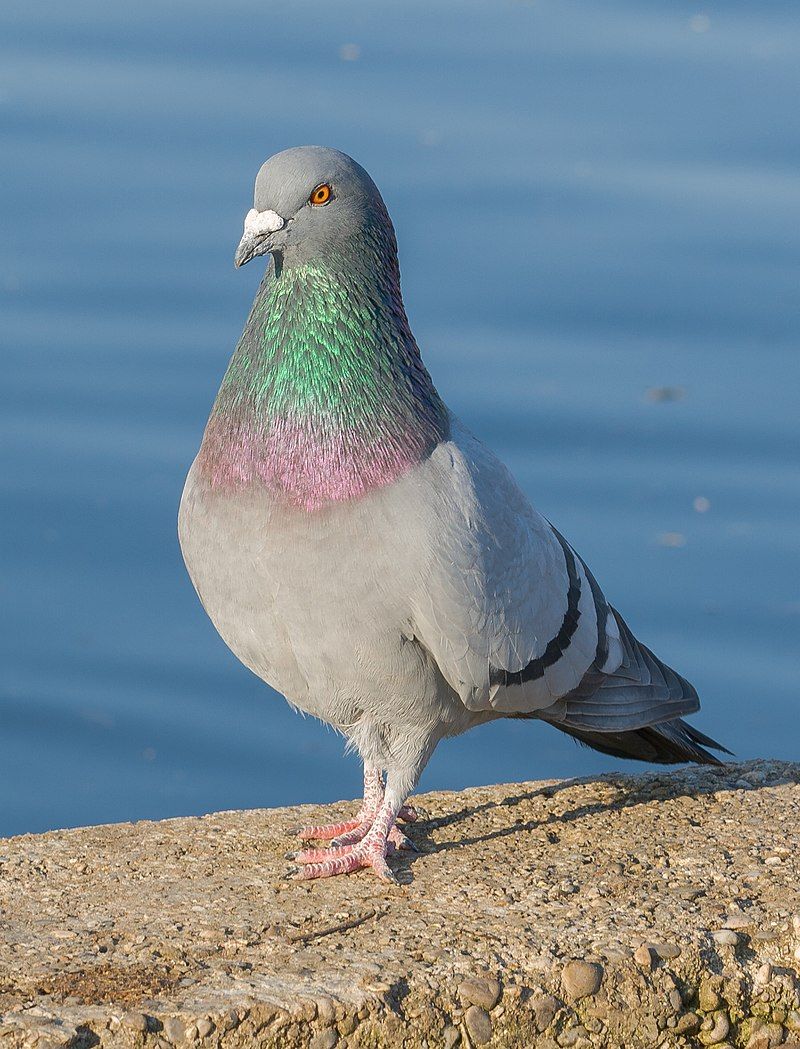
The rock dove, also known as the rock pigeon or the common pigeon, is a bird species that belongs to the Columbidae family. This species is often referred to as the “pigeon” in everyday language.
The domestic pigeon is a descendant of the rock dove, and when domestic pigeons escape, their populations often increase and create a larger feral pigeon population in various parts of the world.
Feral pigeons are highly adaptable and can be found in almost all urban areas, while rock doves are found in mountainous regions. This species is considered a pest in some places due to its expanding population and the mess it creates.
Nonetheless, it remains a beloved bird species in many cultures.
| Kingdom | Animalia |
| Phylum | Chordata |
| Class | Aves |
| Order | Columbiformes |
| Family | Columbidae |
| Genus | Columba |
| Species | C. livia |
24. Common Quail
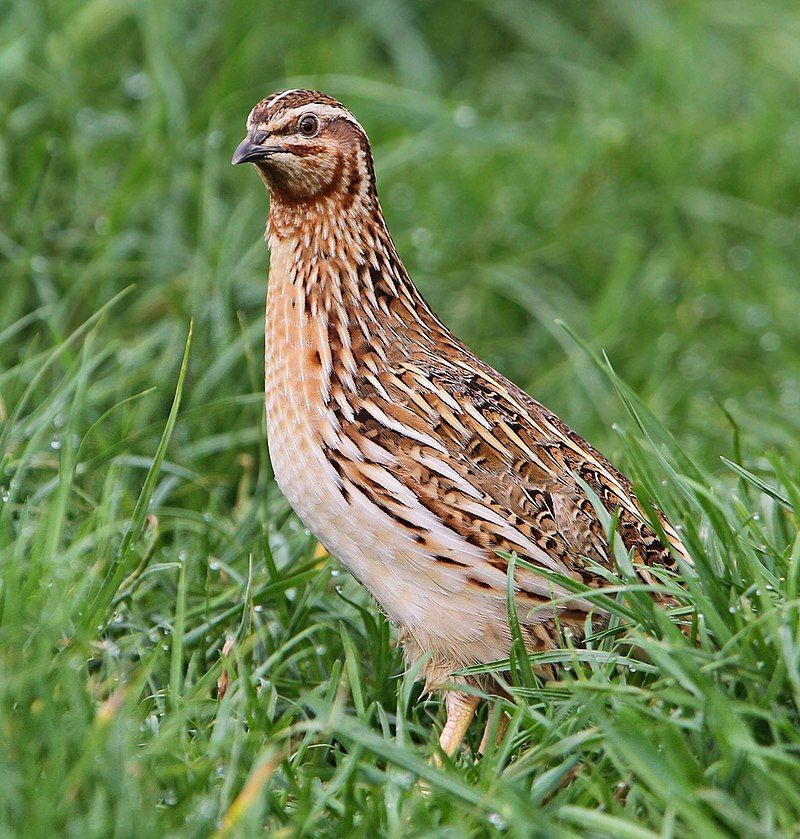
The common quail, or European quail, is a small bird from the pheasant family of birds.
It is a migratory bird, with the majority of the population breeding in the western part of the Palearctic region, which stretches from Europe to Northern Asia, and then travelling south to winter in Africa and Southern India.
This type of quail is rarely seen, but it is well-known for its distinctive call of three repeated chirps. The sound of these birds can often be heard in the early morning or evening, but they usually remain hidden in the undergrowth.
| Kingdom | Animalia |
| Phylum | Chordata |
| Class | Aves |
| Order | Galliformes |
| Family | Phasianidae |
| Genus | Coturnix |
| Species | C. coturnix |
Conclusion
Birds in Oristano are a vital part of the ecosystem and are important to the local flora and fauna. They provide food for other animals, help to control insect populations, and help to pollinate plants.
They provide a wonderful source of entertainment for people of all ages. The people of Oristano should take steps to protect and preserve their bird population so that future generations can enjoy the beauty and benefits of these amazing creatures.